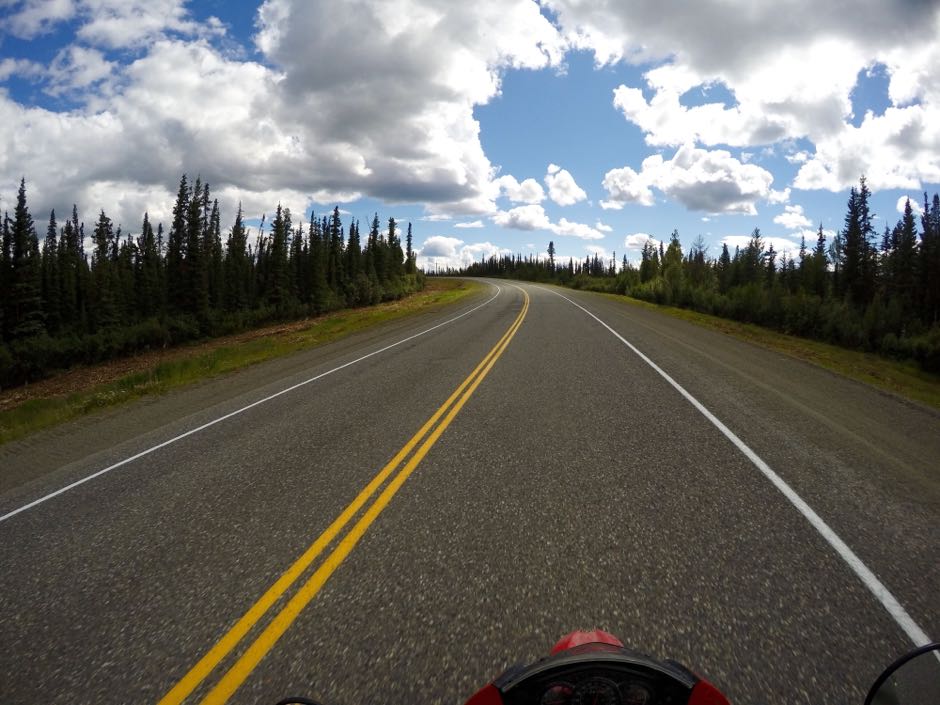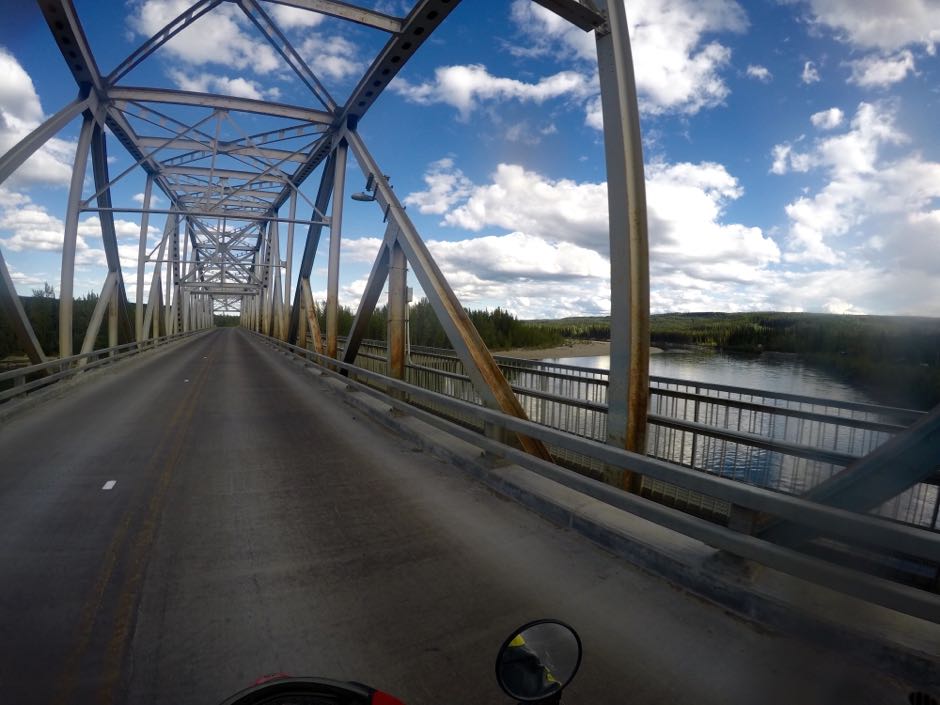Day 22 • Whitehorse to Watson Lake • 300 mi
Older carbureted bikes, such as the KLR, don't have fuel gauges. Instead, they tell you you're running out of gas by running out of gas.
To make this less of a disaster, they "run out of gas" with some left in the tank. This is called the reserve. You must manually change the fuel switch from "on" to "reserve" to use the rest of the fuel. On the KLR, reserve is somewhere around 1.5 gallons, or roughly 60 mi.
It is your responsibility to keep track of fuel levels. I, and most people, do this by resetting the trip odometer every time I fuel up. 0 mi on the trip odo? You're leaving a gas station. 150 mi? You should probably think about fueling soon.

I hit reserve today at 180 mi. I passed up gas at 103, and then the next three stations were closed. Here's what it's like to run out of primary fuel on the KLR:
- slight but noticeable power loss for about half a mile
- instant full power loss
- jump starting on the way down works Temporarily but then dies almost immediately after
- cranking immediately after stopping does nothing
- cranking 2-4 minutes later catches for a bit
Stop me when you've heard this one before.
I might be the dumbest person out here.

I'm keeping a log of every fuel stop and EOD mileage. It gets a little muddled on the Dawson to Carmacks day when I forget to reset the trip odo after a stop.
I logged a trip odo of +21.4 mi my first evening in Whitehorse.
After about 80 mi, the Incident occurred.
Helmet cam evidence following the successful resurrection of the bike points to a trip odo of either 100.7 mi or 200.7 mi.
The hundreds place on the trip odo is sticky—it likes to sit between numbers.
Here's what I think happened: I refuel after waking up in Carmacks (9.08 L, trip odo 235.8, tank distance 114.3). I travel approximately 110 mi south to Whitehorse, plus some back and forth to the dealer. When I arrive at camp, the trip odo says [0|1]21.4, which I log as 21.4. This seems reasonable, as I've been sitting at the dealer for a few hours, and the mileages in the log seem to add up for Carmacks to Whitehorse.
The next morning, I exit Whitehorse with an expected range of 230-21.4~=200mi.
Trust your instruments, right?

At [0|1]97ish indicated, I empty the primary tank. This causes panic, because it is very unexpected. Combined with the surging of a week ago, I assume the bike is disintegrating.
The very first thing I do is to open the tank and look for fuel. There is some: roughly 1.5 gallons, most likely. The Reserve.
In my SOS message to my advising team, I send "Have fuel", cutting that branch neatly out of everyone's debugging trees, including my own.
While futzing with the carb, we happen to switch to reserve. After draining the carb, the bike takes some cranking but then fires right up.
At the gas station just after the Incident, I log 15.8L—just over 4 gallons—far too much for ~100 mi at 45 MPG. I think this is odd and mention it to the attendant who handed me the nozzle, but I assume that the pump somehow didn't zero OR that my MPG somehow dropped by half. I resolve to mention this to the mechanic. I do not.
So uh, yeah. I good at motorcycle.

Lessons:
- Solo trips have very little room for error. There's no one to catch your mistakes.
- Small errors multiply. Forgetting to zero my trip odometer once lead to four hours by the side of the road.
- if someone asks you for help, have them check the obvious. Even if they've already checked it. Even if you're worried they might feel insulted.
- When you check something, check it. Don't rely on your assumptions or memories of state.
- Only after you've actually ruled out low fuel should you start speculating about vacuum lines collapsing under heat.
•

The Yukon remains beautiful, as expected.
Total mileage: 300.6 mi
Trip mileage: 3,114 mi